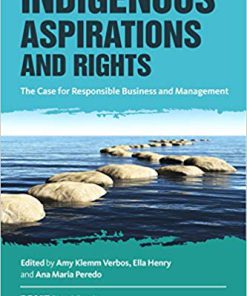(eBook PDF) Responsible Hospitality by Rebecca Hawkins
$50.00 Original price was: $50.00.$35.00Current price is: $35.00.
(eBook PDF) Responsible Hospitality by Rebecca Hawkins – Instant Download
(eBook PDF) Responsible Hospitality by Rebecca Hawkins – Digital Ebook – Instant Delivery Download

Product details:
- ISBN-10 : 1906884196
- ISBN-13 : 978-1906884192
- Author: Rebecca Hawkins (Author), Paulina Bohdanowicz (Author)
The first book to bring together environmental theory and the responsible hospitality debate to define how far the industry has gone and what is left to achieve.
Table contents:
1 Introduction
Part 1: The Theory of Responsible Business
2 The reasons for doing good
3 Defining good – the principles of responsible business
4 Good in the context of hospitality
Part 2: The Environment
Principle 1: Avoid wasteful use of resources and protect and, where possible, improve the environmen
Principle 2: Prepare for the (un)expected
Principle 3: Develop products that are responsible and can be operated responsibly
Part 3: People and communities
Principle 4: Develop mechanisms to take full account of the views of people and communities
Principle 5: Embed responsible business practices throughout the supply chain
Principle 6: Engage employees and customers in actions that support environmental, economic and soci
Principle 7: Contribute to the development of public policy that promotes environmental, social and
Part 4: Fairness and transparency
Principle 8: Define responsible business values and communicate good practice
Principle 9: Build trust through transparency
Part 5: Leadership and Future Directions
Principle 10 : Take responsible business to the heart of the company
5 A Faustian bargain?
Afterword
Glossary of terms
List of acronyms
Index
Figure 1: We would need five of these to sustain a global population living at US standards
Figure 2: Food accounts for almost one quarter of the ecological footprint
Figure 3: The responsible business lingo
Figure 4: Where tourism and hospitality meet
Figure 5: The evolution of the responsible business concept
Figure 6: Doing good – business attitudes towards responsibility. Adapted from Hollins (n.d.)
Figure 7: The emergence of responsible hospitality
Figure 8: McDonald’s keep responsible business at the forefront of customers’ minds
Figure 9: Social and environmental criteria integrated into IFC Investment Decisions
Figure 10: Growth depends on the burgeoning middle class
Figure 11: The main inputs and impacts of hospitality businesses
Figure 12: Average energy consumption in a full service restaurant, USA.
Figure 13: Number of leading hospitality businesses with a commitment to reducing carbon emissions o
Figure 14: Using energy monitoring data to manage consumption within Accor (UK and Ireland) hotels
Figure 15: Carbon emission reductions at apetito
Figure 16: Water consumption benchmarks developed by SydneyWater for restaurants. This study also pr
Figure 17: In-house benchmarks for water used by Scandic Hotels
Figure 18: Water – a cause for concern
Figure 19: Typical waste compositions from different UK profit sector hospitality establishments
Figure 20: The waste minimisation hierarchy
Figure 21: Green Start Benchmarking and Reporting System
Figure 22: Areas under water stress
Figure 23: Hospitality businesses making explicit reference to climate change adaptation within webs
Figure 24: Does the company integrate sustainability issues into design criteria for new build and r
Figure 25: The pressures that engage businesses in responsible choices at new product design and ope
Figure 26: TUI Travel’s publish their own guidelines for sustainability in hotels. (www.tuitravelp
Figure 27: CERES recommendations for stakeholder dialogue.
Figure 28: Defining stakeholders – the case of Sodexo
Figure 29: Green House Gas emissions from food
Figure 30: The steps in engaging suppliers in responsible business initiatives.
Figure 31: Hospitality businesses that actively seek to engage suppliers in responsible business ini
Figure 32: Unilever approach to driving supply chain efficiencies and reducing impacts
Figure 33: Hospitality businesses with a code of ethics for suppliers vis-à-vis employment conditio
Figure 34: Engaging employees in doing good. Adapted from UNEP Finance Initiative, p5
Figure 35: A typical structure for delivering responsible business programmes in the hospitality sec
Figure 36: Businesses claiming to train staff in responsible business issues
Figure 37: Customers would prefer to buy from companies with a commitment to environmental responsib
Figure 38: Actions speak louder than words. Global retail consumers segmented by willingness to pay
Figure 39: Policy Instruments for sustainable consumption
Figure 40: Responsible business ambitions need to link to tangible actions with reach across the com
Figure 41: The prevalence of reporting among hospitality companies
Figure 42: The range of issues covered in responsible business reports published by 14 hospitality b
Figure 43: Sample board structure for dealing with responsible business issues
People also search:
responsible hospitality council
socially responsible hospitality
responsible hospitality practices
responsible hospitality meaning
responsible hospitality examples
responsible hospitality conference
You may also like…
Management
(eBook PDF) Indigenous Aspirations and Rights: The Case for Responsible Business and Management
Ebook-PDF
(eBook PDF) Hospitality Law: Managing Legal Issues in the Hospitality Industry, 5th Edition











